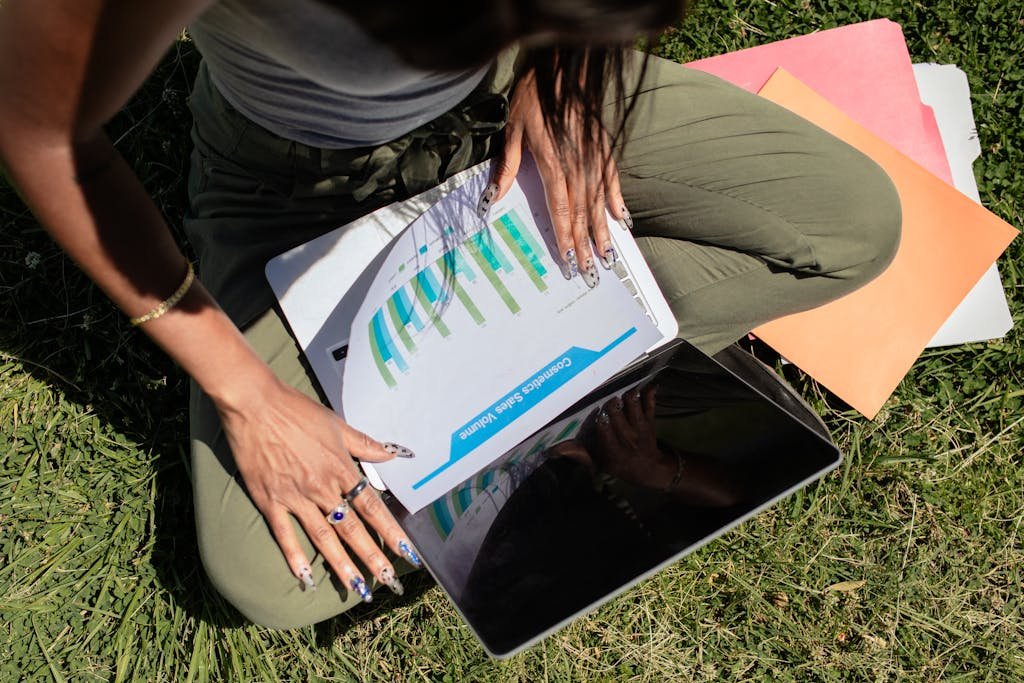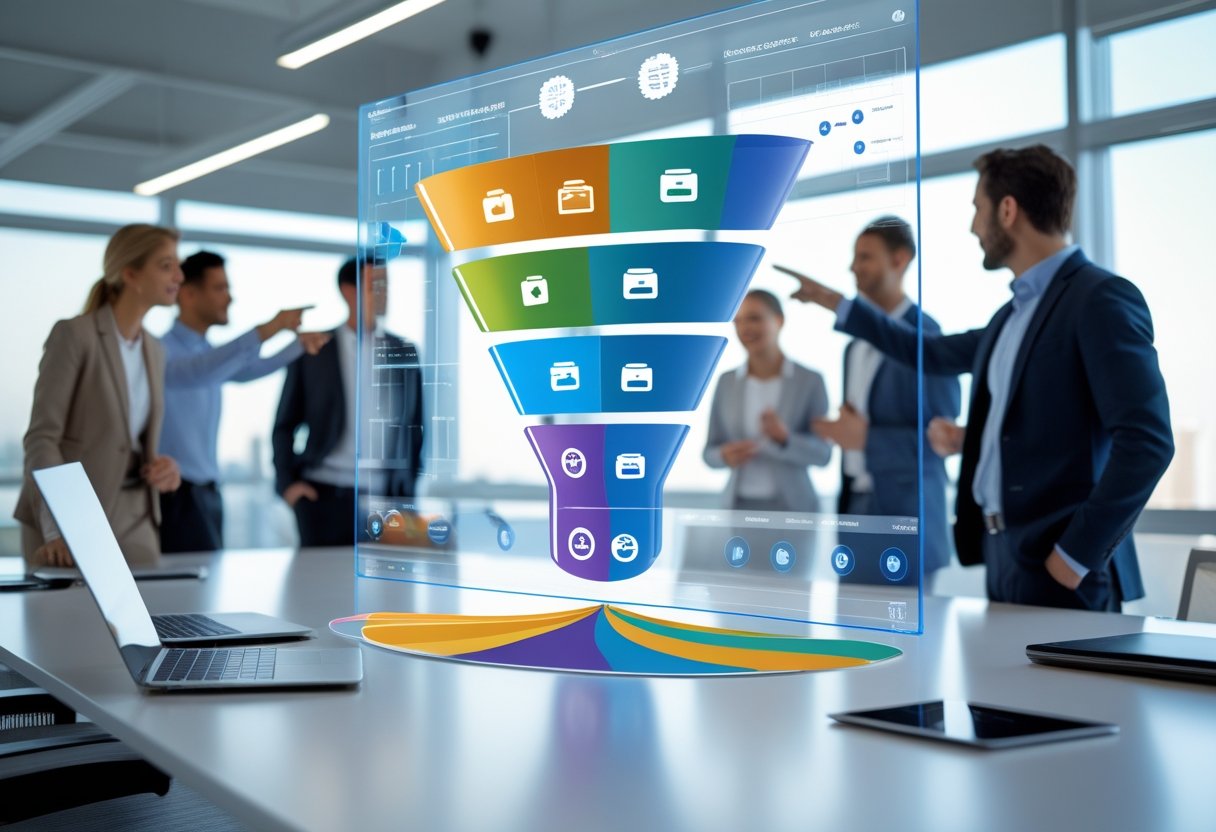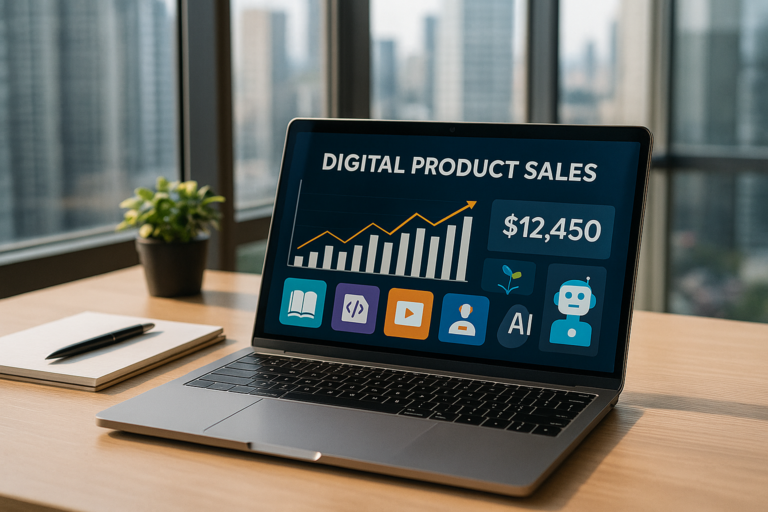Digital Product Funnel Made Easy: A Friendly Step-by-Step Guide for Beginners
A digital product funnel is a step-by-step process that helps you sell your online products more easily. It guides your visitors through different stages, turning them into customers without you needing to be there all the time. A well-made digital product funnel can boost your sales and create a steady stream of income with less effort.

You might wonder how it works or why you need one. The funnel starts by attracting visitors and then offers them small, easy-to-buy products before leading to bigger offers. This keeps people interested while building trust in your brand.
Building your own funnel might sound hard, but it can be simple with the right tools and plan, trust me I’ve done it! And once it’s set up, your funnel works for you automatically, letting you focus on growing your business.
Key Takeaways
- A digital product funnel helps turn visitors into paying customers step by step.
- It makes selling easier by offering products in a natural, trust-building way.
- Setting up a funnel can be simple and run automatically to save you time.
Why You Need a Digital Product Funnel to Make Passive Income

To earn money passively from digital products, you need a smart way to guide people to buy. A digital product funnel, yes it may say odd, but it helps you do this by moving customers step-by-step toward a purchase without constant work from you.
What Is a Digital Product Funnel (Explained for Beginners)
A digital product funnel is a simple path you create online to sell your digital products. It usually starts with attracting visitors through free content or ads. Then, you offer a small free or low-priced product to get people interested.
Once they show interest, you offer bigger products or services. This step-by-step approach helps you turn visitors into buyers over time. For beginners, think of it as a clear map your customers follow toward buying something valuable.
Why Passive Income Doesn’t Happen Without a Sales Funnel
Too many times people try and sell products, but done think about a funnel. Remember passive income means money comes in regularly without you working all the time. But if you don’t guide your customers through a funnel, you’ll need to sell your product every time someone finds you. That means no true “passive” income.
A sales funnel works like your 24/7 salesperson. It handles finding customers, showing your product’s value, and making sales. Without this system, you spend more time chasing buyers instead of letting your product sell itself.
How a Funnel Helps Automate Digital Product Sales
A digital product funnel uses tools like email sequences, landing pages, and automated offers. These tools work together to send the right message at the right time. You set it up once, and it runs without your daily effort.
For example, after a visitor joins your email list, an automated email can offer them a digital course or ebook. If they buy, another email might suggest more products. This automation keeps your sales moving even when you’re not working.
⚡ Want to fast-track your first income funnel?
Download my Free 7-Day AI Income Launch Guide — it’s the exact roadmap I used to go from blank page to monetized blog in one week.
✅ No tech stress, ✅ No experience needed, ✅ Just 1–2 hours/day.
👉 Get Your Free Guide Now — Normally $27
How a Digital Product Sales Funnel Works (From Start to Finish)
A digital product sales funnel guides people from first hearing about your product to buying it and coming back for more. It helps you build trust, collect contact info, make sales, and keep customers engaged over time.
The 4 Stages of a Digital Product Funnel: Attract → Capture → Convert → Follow-Up
First, you attract visitors with things like blog posts, social media, or ads. The goal is to get the right people interested in your product.
Next, you capture their email or contact details by offering a freebie like a guide, checklist, or mini-course. This lets you reach them directly later.
Then comes convert, where you turn those leads into buyers. This often happens through sales pages or emails explaining the benefits and offering easy checkout options.
Finally, you follow-up with customers to build loyalty. This could be through email sequences with tips, reminders for upgrades, or offers for new products.
Tools to Build a Funnel for Digital Products (No Tech Skills Needed)
You don’t need to be a tech expert to build your funnel. Platforms like ClickFunnels, Leadpages, and ConvertKit (which I use) offer drag-and-drop builders to make landing pages and emails without coding.
Many tools include templates for each funnel stage: attracting, capturing leads, and converting sales. They also automate tasks like sending emails or follow-ups so you don’t have to do everything manually.
You can test different headlines or offers easily, too, to see what gets the best results. These tools help you build a funnel quickly and keep it running smoothly.
For example, and AVYX AI we use “Create → Automate → Profit” System
This system fits directly into the “Create → Automate → Profit” funnel method. You create valuable content and a digital product for your audience.
Then, you automate the process with your funnel tools, capturing emails and sending offers without constant effort from you.
This automation turns into profit by making sales continuously, even while you focus on creating new products or improving your business. It helps you scale without extra work after setup.
Step 1 – How to Drive Traffic to Your Digital Product Funnel
Driving traffic means getting people interested in what you’re offering. You want to bring visitors who might buy your product or sign up for your list. Knowing where and how to reach these people is key to building your funnel.
Using Blog Posts and SEO to Attract Leads to Your Funnel
Writing blog posts lets you share helpful info that matches what your audience searches for online. Use keywords related to your product in your titles, headings, and text. This helps your blog show up in search results.
Make sure your posts answer common questions or solve problems your audience has. Add calls to action (CTAs) at the end to guide readers to your funnel, like signing up for a freebie or checking out your product.
Consistency matters. Posting regularly builds trust and improves SEO over time. Use simple language and focus on topics your audience cares about.
How to Create Free Content That Feeds Your Funnel
Free content pulls people into your funnel by offering value without asking for money first. This can be ebooks, videos, checklists, or mini-courses.
Ensure your free content solves a specific problem your audience faces. For example, if your product is about fitness, create a simple workout guide people can download.
Add a form for email sign-up to capture leads before delivering your content. This way, you can follow up and move them deeper into your funnel.
Make your free offers easy to access and share. The easier people can get and spread your content, the more traffic you’ll attract.
Best Platforms to Get Traffic for Your Digital Product Funnel
Focus on platforms where your target audience spends time. Social media sites like Instagram, Facebook, and TikTok work well for visual content and ads.
Email marketing is a strong tool to bring visitors back to your funnel. Build your email list from free content and keep sending helpful updates.
Also consider YouTube if your product suits video tutorials or reviews. YouTube videos can rank well in searches and bring steady traffic.
Paid ads on Facebook and Google can boost traffic quickly. Use small tests to see which ads work best before spending more money.
Step 2 – How to Capture Leads with a High-Converting Lead Magnet
To capture leads effectively, you need a lead magnet that offers real value and connects well with your digital product funnel. Choosing the right tools to create and share your lead magnet will make the process smooth. Then, organizing your leads properly helps you send the right messages that turn them into customers.
What Makes an Effective Lead Magnet for Digital Product Funnels
Your lead magnet must solve a specific problem for your audience. It should be quick to consume, like a checklist, guide, or short video. Keep it simple but helpful to build trust fast.
It works well when the lead magnet leads directly into your tripwire funnel. This means your free offer matches the paid product you want to sell next. For example, if you sell a workout plan, offer a free meal prep guide.
Make sure your lead magnet has a clear call to action. Tell people exactly what to do after they download it, like sign up for a webinar or buy a small product to keep them moving through your funnel.
Free Tools to Design, Host, and Deliver Your Lead Magnet
You can use Canva to design attractive PDFs, images, or workbooks. Canva is easy for beginners and offers many free templates.
For hosting your lead magnet, use Google Drive or Dropbox. These let you store files securely and share download links quickly without extra cost.
To deliver your lead magnet automatically, connect your hosting link to ConvertKit. When someone signs up via your email form, ConvertKit sends the lead magnet link in the welcome email. This saves time and gives your leads instant access.
How to Segment Leads in Your Funnel Using ConvertKit
In ConvertKit, you can tag and segment your leads based on their actions. For example, if someone downloads your lead magnet, tag them as “Interested.”
You can create different email sequences for each tag. This helps you send messages that fit where they are in your funnel. For instance, if they downloaded a free guide, offer an upsell next.
Segmenting your leads also lets you test which emails work best. Then, you can improve your funnel and get more people to buy your digital products.
Step 3 – How to Use a Tripwire Product in Your Funnel
Using a tripwire product can boost your sales by turning visitors into paying customers quickly. You want to create a small, low-cost offer that feels like a great deal. This helps build trust and gets people to engage with you before you offer bigger products.
What Is a Tripwire in a Digital Product Funnel
A tripwire is a low-priced offer that comes after a free lead magnet or opt-in. It is usually something small but valuable, like a mini-course or a downloadable guide.
The goal is to get people to say “yes” to buying something easy. This makes it easier to sell more expensive products later.
Because the tripwire costs less, more visitors will buy it. When they do, you prove your product’s value and start building a paying relationship.
Why $7–$27 Low-Ticket Offers Convert Better
Offers in the $7 to $27 range tend to work best because the price feels low enough to take a chance. It’s not a big risk for customers, so more people buy.
At that price, you cover some of your costs while keeping the buyer interested. This price also makes the next upsell easier to accept.
If you price too high, people may hesitate. If you price too low, it can hurt how they see your product’s value.
Examples of Beginner-Friendly Tripwire Digital Products
Here are some simple tripwire ideas you can use:
- Ebooks that teach a specific skill or fix a problem
- Checklists or templates that save time and effort
- Mini online courses that give quick, useful lessons
- Printable planners or worksheets for planning or organizing
- Exclusive video tutorials on a narrow topic
Each of these is easy to create and sells well at a low price. They also help you show your expertise and prepare customers for bigger purchases.
Step 4 – How to Automate Your Funnel with Email Marketing
To make your digital product funnel work smoothly, you need a well-planned email system. This helps you stay connected with potential buyers, build trust, and guide them toward buying more products automatically. You’ll learn how to create helpful email sequences, write emails that encourage sales, and use automation to offer extra products.
How to Build a Nurture Email Sequence for Your Funnel
Start by mapping out a sequence of emails that slowly build a relationship with your audience. Begin with a welcome email that thanks them and explains what to expect. Then, send helpful content that solves their problems related to your digital product.
Send 4 to 6 emails over two weeks. Each should offer useful tips, answer common questions, or share testimonials. End the sequence with a clear call to action, like a special offer or invitation to buy.
Use an email marketing tool to schedule these emails. This way, they go out automatically after someone signs up, saving you time and keeping your funnel active.
Best Practices for Writing Emails That Convert into Sales
Keep your emails short and easy to read. Use simple language and clear subject lines that grab attention. Make sure the content focuses on benefits, showing readers how your digital product helps them.
Include a single call to action in each email, like “Buy Now” or “Learn More.” Use buttons or links that stand out visually. Personalize emails by using the recipient’s name to make it feel more friendly.
Avoid jargon, salesy language, or too many links. Instead, tell a story or share a quick tip that builds trust. Proofread to avoid errors and test your emails on different devices before sending.
How to Upsell Your Digital Products Using Automation
After a purchase, set up emails that suggest related or more advanced digital products. Use automation to send these upsell emails a few days later while the buyer is still interested.
Highlight the extra product’s value and explain how it complements their first purchase. Offer limited-time discounts to encourage quick decisions.
Segment your email list based on what each customer has bought. This helps you send relevant upsell offers that fit their needs better. Automation tools can handle this automatically, sending personalized offers without extra work from you.
Best Tools to Build a Digital Product Funnel (No Code Needed)
You need easy-to-use tools that help you create content, design lead magnets, build landing pages, and handle payments without coding. The right software lets you focus on selling digital products online while keeping everything smooth and simple.
KoalaWriter for Blog Posts and Funnel Content
KoalaWriter helps you write clear blog posts and funnel content fast. It’s built to generate ideas, outlines, and drafts automatically, so you don’t have to start from scratch.
You can ask it to make product descriptions, emails, or landing page copy. This saves time and keeps your message consistent across all parts of your funnel. You just need to tweak the text to make it fit your style.
Since it’s simple and online, you don’t need tech skills to use it. This makes it perfect for getting your funnel words ready quickly.
Canva for Lead Magnet and Product Design
Canva is a great tool for creating eye-catching lead magnets like ebooks, checklists, and guides. It uses drag-and-drop features, so it’s super easy to design even if you’re new to graphic software.
You can choose from thousands of templates customized for digital products. Canva also lets you create visuals for your funnel, such as social media posts or product covers.
You can export files in different formats and use them inside your funnel. This way, your lead magnets and product designs look professional and match your brand.
ConvertKit for Landing Pages and Email Automations
ConvertKit lets you build email lists and create landing pages without coding. The landing page editor has pre-built templates that you can customize fast by adding your text and images.
It has automation tools that send emails based on subscriber actions. You can set it up to deliver lead magnets, send product offers, or follow up automatically.
This tool helps keep your audience engaged by sending the right message at the right time. It also tracks email performance, so you can see what works.
Gumroad or ThriveCart for Checkout and Delivery
Gumroad and ThriveCart are popular platforms to handle payments and product delivery. You can sell digital products like ebooks, courses, or software without setting up complicated shopping carts.
Gumroad is easy to start with and manages subscription payments and instant downloads. It’s good for small businesses or solo creators selling directly to customers.
ThriveCart offers more features, including upsells, coupon codes, and detailed sales reporting. It’s useful if you want more control over your checkout process and grow your sales.
Both tools protect your digital files and automate product delivery right after purchase.
Beginner-Friendly Funnel Example: Our 7-Day AI Income Launch Plan
It’s easy to get stuck before you even start. That’s why I created a simple, actionable funnel that shows you how to launch your first income stream in just one week.
Here’s the exact structure:
🔹 Day 1–2: Launch Your Blog (Without Tech Stress)
Use AI tools like KoalaWriter to pick your niche, set up your WordPress blog, and choose your first topic. You don’t need design or tech experience — the plan walks you through everything step-by-step.
🔹 Day 3–5: Write and Publish 3 Monetized Blog Posts
With KoalaWriter and a few strategic prompts, you’ll have three long-form blog posts written and optimized in just a few hours — complete with affiliate links to products you trust.
🔹 Day 6: Set Up Your Funnel (Lead Magnet + Email List)
Using ConvertKit, you’ll connect your free guide (like the one you’re reading now) to a landing page and email automation. That means every new reader becomes a subscriber and potential buyer.
🔹 Day 7: Launch + Promote
You’ll learn how to publish your funnel, share it on social, and begin driving traffic — even with zero audience. This final day pulls everything together so your system runs on autopilot.
Why This Funnel Works (Even If You’re Just Starting)
This 7-day system follows the “Create → Automate → Profit” model used by successful creators:
- Create a blog and digital product fast with AI
- Automate your funnel using ConvertKit and email sequences
- Profit by promoting affiliate tools and growing your list
It’s the exact same strategy I used to launch AVYX AI — and it’s built for solopreneurs, creators, and beginners who want results quickly without getting overwhelmed.
🎁 Want the full plan with templates and checklists?
Grab the Free 7-Day AI Income Guide (Normally $27 — Free Today)
Final Steps: Launch Your Digital Product Funnel in 2025
Launching your digital product funnel takes careful preparation and action. You’ll focus on moving through crucial stages, understanding why it’s important to start even if you feel uncertain, and using practical tools to help you begin quickly.
Recap: The 4 Stages of a Digital Product Funnel
Your funnel has four key stages: Attract, Engage, Convert, and Deliver.
- Attract: Use ads or content to get people’s attention.
- Engage: Offer something valuable like a freebie or demo.
- Convert: Turn interested people into customers by presenting your main offer.
- Deliver: Make sure your product reaches customers smoothly and supports their use.
Each step builds trust and guides prospects toward buying your product.
Why You Should Launch Before You Feel Ready
Waiting for everything to be perfect can stop your progress. If you launch early, you get real feedback from customers that helps you improve.
Mistakes are part of learning. Starting now means you can adjust your funnel with actual data, not just guesses.
Launching also builds momentum and shows you what works. This approach saves time and avoids endless planning without results.
Download the Free 7-Day Blog Funnel Guide to Start Building
A helpful tool is the free 7-Day Blog Funnel Guide. It breaks down the funnel setup into easy daily steps.
You’ll learn how to pick topics, write posts, and connect your blog to your product offers.
It’s designed to get your funnel working fast, even if you’re new to online marketing. Grab this guide and use it to build a strong foundation for your digital product funnel.
Frequently Asked Questions
You will learn about the main steps in a sales funnel and how to build landing pages that make visitors want to act. Tips on improving your funnel and managing it well will help you get better results. You will also see how testing and good copywriting can boost your success.
What are the key stages of a successful sales funnel?
A good funnel usually has four stages: awareness, interest, decision, and action. You first attract attention, then build interest in your product. Next, help people decide by answering their questions. Finally, get them to buy or sign up.
How can I create a high-converting landing page for my funnel?
Make your landing page clear and focused on one goal. Use simple headlines and strong calls to action. Include images or videos to explain your product fast. Keep the design clean and remove distractions.
In what ways can I optimize my marketing funnel for better conversion rates?
Check where people drop off and fix those points. Test different headlines, offers, and page layouts. Use email follow-ups to re-engage interested visitors. Make sure your funnel loads fast and works on phones.
What are some of the best practices for sales funnel management?
Track your funnel’s performance with tools like Google Analytics. Regularly update your content to keep it fresh. Listen to customer feedback to improve offers. Stay consistent with branding and messaging.
How do A/B testing strategies impact the effectiveness of digital product funnels?
A/B testing lets you compare two versions of a page or email. This helps you find out what works better with your audience. By testing headlines, images, or buttons, you can improve click rates and sales.
Can you share some effective copywriting tips for engaging potential customers in a funnel?
Use clear and simple words that your audience understands. Write benefits, not just features. Ask questions and include stories to keep readers interested. Always end with a call to action that tells them what to do next.
About the Author
Chris @ AVYX AI is a former digital exec turned online entrepreneur. He helps beginners build passive income streams using AI tools — without tech overwhelm. At AVYX AI, he shares step-by-step systems anyone can use to Create → Automate → Profit. Learn more about Chris or grab the free guide to launch your first income stream.






